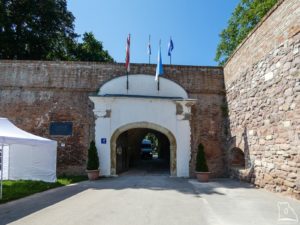Szigetvár

The most important thing about Szigetvár castle is the famous siege of 1566: although it fell to the Turks, the besiegers suffered very heavy losses, not to mention the death of Sultan Suleiman. In the 17th century, Cardinal Richelieu described the siege of Szigetvár as “the battle that saved civilization.” Indeed, the heroic last stand of Croatian and Hungarian soldiers saved Western Europe from the onslaught of the Ottoman Empire.

Szigetvár castle was the southern gate of Hungary in the Ottoman wars but it had always been strategically very important.
Its name appeared first in writing in 1391 and Szigeti Antimus Osvát was its owner in the 15th century who built its first four bastions. The place became an “oppidum” (agricultural city) in 1463.

The city and the castle were bought by the Török family of Enying in 1473. Török Bálint, the most famous member of this family, had the castle built into a fortress in the 1530s. (Please, note that I use the Oriental name order for Hungarians where family names come first.) In the first part of the Ottoman peril, the place was not only an economic and military base but it was also a cultural center.

Tinódi Lantos Sebestyén, the famous Hungarian poet and lutist used to live there until 1542 and the poet Pálffy István also had a house there where his son, Pálffy Miklós, the great chronicler was born. After Török Bálint became the Turks’ prisoner, Szigetvár went to the property of King Habsburg Ferdinand in 1543. The Ottomans had occupied many castles in the Trans-Danubian Region between 1540-1550 so Szigetvár got isolated as an “island”. (‘Sziget’ stands for ‘island’ and ‘vár’ means ‘castle’.) Its captain was Kerecsényi László at that time who repelled the first attack in 1554.

Two years later it was besieged again when Captain Horváth Stancsics Márk was able to hold the fort under very hard conditions against the overwhelming army of Ali, the Pasha of Buda. After the siege, the ruined fort was reinforced with the help of Italian engineers, and thus it has become the strongest and most up-to-date castle in the 1,000-mile-long Hungarian Borderland. You can read the details of this siege on my page:
https://www.hungarianottomanwars.com/1541-1699/the-siege-of-szigetvar-in-1556/

The Croatian aristocrat and successful general, Zrínyi Miklós (Nikola Šubić Zrinski) became its captain in 1561. This fort was threatening the Turks’ logistic transport between Nándorfehérvár (Belgrade) and Buda. As we have said, the most famous event about Szigetvár is its siege when the Ottomans gained a pyrrhic victory in 1566. This is the full video about the siege with English subtitles:
https://www.youtube.com/watch?v=RXKbSDtHY5k

The castle was defended by Zrínyi Miklós in 1566 against Sultan Suleiman and his army of 80,000 Ottomans, 15,000 Crimean Tatars, and 7,000 Moldavian troops. It goes without mentioning, that the Habsburgs sent no help to their Hungarian battlefield. The siege began on 6 August and ended on 7 September.

Zrínyi Miklós (Nikola Šubić Zrinski), the great-grandfather of our poet and general Zrínyi Miklós (Nikola Zrinski) had only 3,000 Hungarian and Croatian soldiers and 54 cannons but he was able to hold the small castle for thirty-four days. Szigetvár was divided into three sections separated by water: the old town, the new town, and the castle. At last, the Sultan tried to entice Zrinyi to surrender, ultimately offering him leadership of Croatia under Ottoman influence. Naturally, Zrínyi turned the offer down.

The Sultan’s lucky day was 29 August and his officers wanted to please him by taking the castle on that day. However, the huge assault was bloodily repelled and the attackers suffered enormous losses. It is thought that Suleiman was so angry that he got a stroke that caused his death a few days later. The Ottoman soldiers were not informed about it, though.

The final battle began on 7 September, just 12-13 hours after Suleiman’s demise. By this time, the fortress walls had been reduced to rubble by mining with explosives and wood-fueled fires at the corners of the walls. In the morning an all-out attack began with fusillades from small arms, “Greek fire”, and a concentrated cannonade. Soon the castle, the last stronghold within Szigetvár, was set ablaze and cinders fell into the apartments of the count. Only 200 soldiers were still alive and 600 civilians.

At this point, Zrínyi ordered the execution of all of his Turkish prisoners and had all his treasures burned. When even the inner castle was in flames, Zrínyi led his remaining 300 men out of the castle, leaving some troops behind the walls, and attacked the Ottomans. These were his last words:
“Let us go out from this burning place into the open and stand up to our enemies. Who dies – he will be with God. Who dies not – his name will be honored. I will go first, and what I do, you do. And God is my witness – I will never leave you, my brothers and knights!”

As the Turks were also pressing forwards along a narrow bridge the defenders suddenly flung open the gate and gave the order to fire a large cannon. An artilleryman called Szerencses Márk tried to ignite it but he was hit by a bullet fired by a Jannissary. Thus, another soldier jumped there, Horváth György who could fire the cannon loaded with broken iron, which was allegedly killing 600 attackers.
Zrínyi then ordered a sally and led his troops out of the castle. He wore his best dress and put 100-100 Gold forints in each pocket, along with the key to the castle. He said that he should not be killed without giving a reward to the soldier who could kill him. He wore a nice hat with feathers in it and drew his jeweled saber.

Zrínyi was the one who rushed out first, he was closely followed by Juranics Lőrinc who carried the flag of the Trans-Danubian Captain. The rest of the survivors ran after them. Zrínyi received two musket wounds, the first on his waist and the second on his forehead, and allegedly he was hit also by an arrow. The Agha of the Janissaries laid his dead body on a cannon the Turks had taken from Katzainer’s army and severed Zrínyi’s head. then, he sent it to the Grand Vizier Szokollu Mehmed. The Vizier later had the body of Zrínyi buried but his head was sent to the Vizier’s nephew, the Pasha of Buda. Then, Pasha Szokollu Musztafa forwarded it to Habsburg Maximilian to Vienna who received it after 11 September.

However, before leading the final sortie by the castle garrison, Zrinyi had ordered a fuse be lit to the powder magazine. After cutting down the last of the defenders the besiegers poured into the fortress. The Ottoman soldiers thronged into the remains of Szigetvár and fell into the booby trap; thousands perished in the blast when the castle’s magazine exploded. The Vizier and his mounted officers had just enough time to escape but 3,000 Ottomans perished in the explosion.

Most of the defenders were slain but a few of them were spared by Janissaries who had admired their courage, with only seven defenders managing to escape through the Ottoman lines. Zrínyi’s nephew, a
Alapy Gáspár was taken in captivity, along with his scribe, Franjo Črnkó (aka Cserenko Ferenc). They were later ransomed by Zrínyi György, the son of Zrínyi Miklós. Having returned home, Cserenko summarized the history of the siege in his chronicle. Zrinyi’s heroic example became a legend in Hungary. It was the last siege of old Suleiman, too; he died under the castle, and his heart was buried there in a Turbe. According to the latest research (by Varga Szabolcs and Fodor Pál, 2016), Suleiman died on the same day as Zrínyi, on 7 September.

The Turks had great losses, 7,000 Janissaries and 28,000 other soldiers are said to have perished. Vienna had not been threatened directly again until the Battle of Vienna in 1683. Szigetvár became an important Sanjak center of the Ottoman Occupied Lands in Hungary and the Turks have properly rebuilt it.

As for the Turbe, the grand-grandson of Zrínyi who was also called Zrínyi Miklós could not take Szigetvár but he occupied the Turbe during his famous Winter Campaign of 1664, and he gave strict orders not to disturb the tomb. Sadly, the Habsburgs sabotaged his campaign. You can read more about the Zrínyi family on my page:
https://www.hungarianottomanwars.com/essays/the-zrinyi-family-and-the-habsburgs/

The recapture of Szigetvár in 1689
Szigetvár had to wait 25 more years until it was liberated during the Reconquest Wars of Hungary. Nothing proves the strength of Szigetvár better than the fact that it was taken only three years after the conquest of Buda. At that time, almost the entire southern Danube Region was under the control of the imperial armies. In the fall of 1686, after the recapture of Buda, Grand Duke Louis of Baden recaptured Kaposvár, Koppány, Simontornya, Pécs and Siklós. However, Szigetvár (and Kanizsa) were such well-defended strongholds that he did not attempt a siege. The following year the main Ottoman army was defeated at Nagyharsány, and the fighting continued in the Szerémség and then in Serbia, far from the isolated Szigetvár.








Source: mainly from Szibler Gábor
Dear Readers, I can only make this content available through small donations or by selling my books or T-shirts:
Please, feel free to support me with a coffee here:
You can check out my books on Amazon or Draft2Digital, they are available in hardcover, paperback, or ebook:
https://www.amazon.com/dp/198020490X or at https://books2read.com/b/boYd81

My work can also be followed and supported on Patreon: Become a Patron!http://Become a Patron!
[wpedon id=”9140″]

https://hungarianottomanwars.myspreadshop.com/all


















































